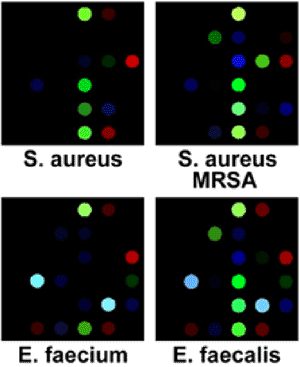Color Changing Pigments Identify Infectious Bacteria
By LabMedica International staff writers
Posted on 09 May 2011
An inexpensive scanner coupled with color changing pigments can be used to identify infectious bacteria by their smell, according to a new study.Posted on 09 May 2011
Researchers at the University of Illinois (Urbana-Champaign, USA) used a disposable colorimetric sensor array for the rapid identification of both species and specific strains of human pathogenic bacteria grown on standard agar, using the volatile gases they produce. The researchers spread blood samples on Petri dishes of a standard growth gel, attached an array to the inside of the lid of each dish, and then inverted the dishes onto an ordinary flatbed scanner. Every 30 minutes, they scanned the arrays and recorded the color changes in each dot; the pattern of color change over time is unique to each bacterium.

Image: Colorimetric sensor array of several pathogens (Photo courtesy of University of Illinois).
In only a few hours, the array not only confirmed the presence of bacteria, but identified specific species and strain. All 10 strains of bacteria tested, including Enterococcus faecalis and Staphylococcus aureus and their antibiotic-resistant forms, were identified with 98.8% accuracy within 10 hours, a clinically important time frame. Furthermore, the colorimetric sensor arrays also proved useful as a simple research tool for the study of bacterial metabolism, and as an easy method for the optimization of bacterial production of fine chemicals or other fermentation processes. The array can even recognize antibiotic resistance, a key factor in treatment decisions. The study was published in the April 27, 2011, issue of the Journal of the American Chemical Society.
"The progression of the pattern change is part of the diagnosis of which bacteria it is," said lead author Kenneth Suslick, PhD, who also cofounded iSense Systems, the company which is commercializing the array technology for clinical use. "It's like time-lapse photography. You're not looking just at a single frame; you're looking at the motion of the frames over time."
Related Links:
University of Illinois













